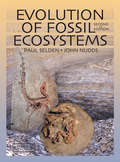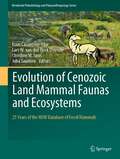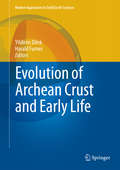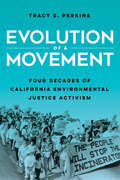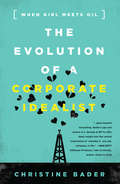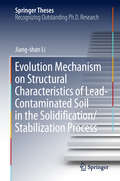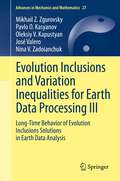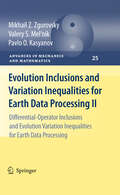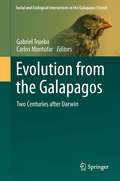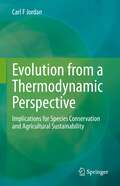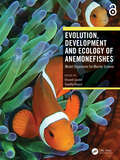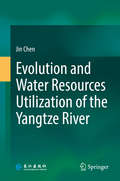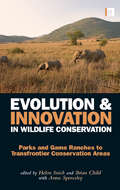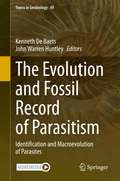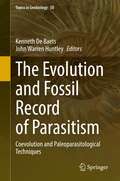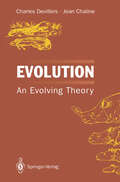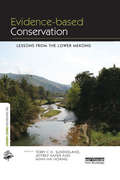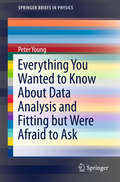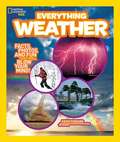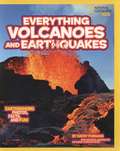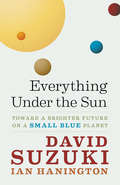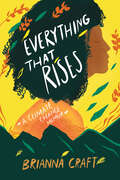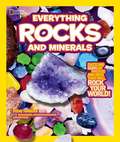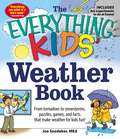- Table View
- List View
Evolution of Fossil Ecosystems
by Paul Selden John NuddsEvolution of Fossil Ecosystems describes all of the main Fossil Lagerstätten (sites of exceptional fossil preservation) from around the world in a chronological order. It covers the history of research, stratigraphy and taphonomy, main faunal and floral elements, and the palaeoecology of each site and gives a comparison with coeval sites around the w
Evolution of Cenozoic Land Mammal Faunas and Ecosystems: 25 Years of the NOW Database of Fossil Mammals (Vertebrate Paleobiology and Paleoanthropology)
by Isaac Casanovas-Vilar Lars W. van den Hoek Ostende Christine M. Janis Juha SaarinenThis volume presents an array of different case studies which take as primary material data sourced from the NOW (‘New and Old Worlds’) database of fossil mammals. The NOW database was one of the very first large paleobiological databases, and since 1996 it has been expanded from including mainly Neogene European land mammals to cover the entire Cenozoic at a global scale. In the last two decades the number of works that are based in the use of huge databases to explore ecological and evolutionary questions has increased exponentially, and even though the importance of big data in paleobiological research has been outlined in selected chapters of general works, no volume has appeared before this one which solely focuses on the databases as a primary source in reconstructing the past. The purpose of this book is to provide an illustrative volume showing the importance of big data in paleobiological research, and presenting a broad array of unpublished examples and case studies. The book is mainly aimed to professional palaeobiologists working with Cenozoic land mammals, but the scope of the book is broad enough to fit the interest for evolutionary biologists, paleoclimatologists and paleoecologists.The volume is divided in four parts. The first part includes two chapters on the development of large paleobiological databases, providing a first-hand account on the logic and the functioning of these databases. This is a much-needed perspective which is ignored by most researchers and users of such databases and, even if centered in the NOW database, the lessons that can be learned from this part can be extended to other examples. After this introductory part, the body of the book follows and is divided into three parts: patterns in regional faunas; large scale patterns and processes; and ecological, biogeographical and evolutionary patterns of key taxa. Each chapter is written by well-known specialists in the field, with some participation of members of the NOW advisory board. The array of selected mammal taxa ranges from carnivores, equids, ruminants and rodents to the genus Homo. The topics studied also include the diversification and radiation of major clades, large-scale paleobiogeographical patterns, the evolution of ecomorphological patterns and paleobiological problems such as evolution of body size or species longevity. In most cases the results are discussed in relation to protracted environmental or paleogeographic changes.
Evolution of Archean Crust and Early Life
by Yildirim Dilek Harald FurnesThis book presents an integrated approach to the study of the evolution of the Archean lithosphere, biosphere and atmosphere, and as such it is a unique contribution to our understanding of the early Earth and life. The structural and geochemical make-up of both the oceanic and continental crust of the Archean Earth is documented in some case studies of various cratons, and the implications of the Phanerozoic plate and plume tectonic processes for the Archean geology are discussed in several chapters in the book. All chapters are process-oriented and data-rich, and reflect the most recent knowledge and information on the Archean Earth. The interdisciplinary approach of examining the evolution of the Archean crust, oceans, and life that we adopt in this book sets it apart from previous publications on Precambrian geology. The book will be attractive to researchers in academia and in industry, and to senior undergraduate students, graduate students and faculty in earth and natural sciences.
Evolution of a Movement: Four Decades of California Environmental Justice Activism
by Tracy E. PerkinsDespite living and working in California, one of the county's most environmentally progressive states, environmental justice activists have spent decades fighting for clean air to breathe, clean water to drink, and safe, healthy communities. Evolution of a Movement tells their story—from the often-raucous protests of the 1980s and 1990s to activists' growing presence inside the halls of the state capitol in the 2000s and 2010s. Tracy E. Perkins traces how shifting political contexts combined with activists' own efforts to institutionalize their work within nonprofits and state structures. By revealing these struggles and transformations, Perkins offers a new lens for understanding environmental justice activism in California. Drawing on case studies and 125 interviews with activists from Sacramento to the California-Mexico border, Perkins explores the successes and failures of the environmental justice movement in California. She shows why some activists have moved away from the disruptive "outsider" political tactics common in the movement's early days and embraced traditional political channels of policy advocacy, electoral politics, and working from within the state's political system to enact change. Although some see these changes as a sign of the growing sophistication of the environmental justice movement, others point to the potential of such changes to blunt grassroots power. At a time when environmental justice scholars and activists face pressing questions about the best route for effecting meaningful change, this book provides insight into the strengths and limitations of social movement institutionalization.
The Evolution of a Corporate Idealist: When Girl Meets Oil
by Christine BaderThere is an invisible army of people deep inside the world's biggest and best-known companies, pushing for safer and more responsible practices. They are trying to prevent the next Rana Plaza factory collapse, the next Deepwater Horizon explosion, the next Foxconn labor abuses. Obviously, they don't always succeed.Christine Bader was one of those people. She loved BP and then-CEO John Browne's lofty rhetoric on climate change and human rights--until a string of fatal BP accidents, Browne's abrupt resignation under a cloud of scandal, and the start of Tony Hayward's tenure as chief executive, which would end with the Deepwater Horizon disaster. Bader's story of working deep inside the belly of the beast is unique in its details, but not in its themes: of feeling like an outsider both inside the company (accused of being a closet activist) and out (assumed to be a corporate shill); of getting mixed messages from senior management; of being frustrated with corporate life but committed to pushing for change from within.The Evolution of a Corporate Idealist: Girl Meets Oil is based on Bader's experience with BP and then with a United Nations effort to prevent and address human rights abuses linked to business. Using her story as its skeleton, Bader weaves in the stories of other "Corporate Idealists" working inside some of the world's biggest and best-known companies.
Evolution Mechanism on Structural Characteristics of Lead-Contaminated Soil in the Solidification/Stabilization Process (Springer Theses)
by Jiang-Shan LiThis book highlights the use of Solidification/Stabilization (S/S) to treat lead-contaminated soils, which are widely present in China. It reveals the evolutionary mechanism of the structural characteristics of Pb contaminated soil during the S/S process. In addition, the book systematically analyzes laws influencing the S/S process and its internal mechanisms, and develops new models for the strength prediction and Pb leaching prediction of S/S monolith. The results can provide essential theoretical guidance and parameter-related support for the design of Pb-contamiated soil S/S remediation and recycling solutions.
Evolution Inclusions and Variation Inequalities for Earth Data Processing III
by José Valero Mikhail Z. Zgurovsky Nina V. Zadoianchuk Oleksiy V. Kapustyan Pavlo O. KasyanovIn this sequel to two earlier volumes, the authors now focus on the long-time behavior of evolution inclusions, based on the theory of extremal solutions to differential-operator problems. This approach is used to solve problems in climate research, geophysics, aerohydrodynamics, chemical kinetics or fluid dynamics. As in the previous volumes, the authors present a toolbox of mathematical equations. The book is based on seminars and lecture courses on multi-valued and non-linear analysis and their geophysical application.
Evolution Inclusions and Variation Inequalities for Earth Data Processing I
by Pavlo O. Kasyanov Mikhail Z. Zgurovsky Valery S. Mel'NikHere, the authors present modern mathematical methods to solve problems of differential-operator inclusions and evolution variation inequalities which may occur in fields such as geophysics, aerohydrodynamics, or fluid dynamics. For the first time, they describe the detailed generalization of various approaches to the analysis of fundamentally nonlinear models and provide a toolbox of mathematical equations. These new mathematical methods can be applied to a broad spectrum of problems. Examples of these are phase changes, diffusion of electromagnetic, acoustic, vibro-, hydro- and seismoacoustic waves, or quantum mechanical effects. This is the first of two volumes dealing with the subject.
Evolution from the Galapagos: Two Centuries after Darwin
by Carlos Montúfar Gabriel TruebaThis volume is a collection of the some of the most significant lectures that well-known experts presented at our two international "summits on evolution" (2005, 2009) as updated and revised chapters. The meetings took place on one of the large islands of the Galapagos archipelago (San Cristobal) at GAIAS (Galapagos Institute for the Arts and Sciences) of the Universidad San Francisco de Quito (USFQ), Ecuador. The main goal of the two Galapagos Summits on Evolution has been to bring together scientists and graduate students engaged in the study of evolution, from life's origin to its current diversity. Because of their historical significance, the Galapagos are a unique venue for promoting comprehensive research on evolution and ecology and to make the research results available to students and teachers everywhere, but especially from developing countries. As shown by the enthusiastic attendance at both summits and the many suggestions to keep them continuing, the meetings have opened new opportunities for students from Ecuador and other Latin American countries to be inspired by some of the most brilliant minds in evolutionary science.
Evolution from a Thermodynamic Perspective: Implications for Species Conservation and Agricultural Sustainability
by Carl F JordanSurvival of the fittest” is a tautology, because those that are “fit” are the ones that survive, but to survive, a species must be “fit”. Modern evolutionary theory avoids the problem by defining fitness as reproductive success, but the complexity of life that we see today could not have evolved based on selection that favors only reproductive ability. There is nothing inherent in reproductive success alone that could result in higher forms of life. Evolution from a Thermodynamic Perspective presents a non-circular definition of fitness and a thermodynamic definition of evolution. Fitness means maximization of power output, necessary to survive in a competitive world. Evolution is the “storage of entropy”. “Entropy storage” means that solar energy, instead of dissipating as heat in the Earth, is stored in the structure of living organisms and ecosystems. Part one explains this in terms comprehensible to a scientific audience beyond biophysicists and ecosystem modelers. Part two applies thermodynamic theory in non-esoteric language to sustainability of agriculture, and to conservation of endangered species. While natural systems are stabilized by feedback, agricultural systems remain in a mode of perpetual growth, pressured by balance of trade and by a swelling population. The constraints imposed by thermodynamic laws are being increasingly felt as economic expansion destabilizes resource systems on which expansion depends.
Evolution, Development and Ecology of Anemonefishes: Model Organisms for Marine Science
by Vincent Laudet and Timothy RavasiAnemonefishes, one of the most popular and recognizable of fishes in the world, are much more than film characters; they are also emerging model organisms for studying the biology, ecology, and evolution of coral reef fishes. They are a group of 28 species often employed to study patterns and processes of social organization, intra- and inter-specific competition, sex change, mutualism, dispersal and connectivity of fish populations, habitat selection, pigment pattern formation, lifespan and predator-prey interactions. This multi-authored book covers all these areas and provides an update on the research done with this model and the perspective it opens for the future. Key Features Contains basic and up-to-date information on an emerging fish model Allows non-specialist readers to grasp the relevance of a wide research area Provides accurate and easy to access information on each of the 28 species Includes guidance for establishing a breeding colony Documents that anemonefishes are useful model organisms for ecological, developmental and climate research The Open Access version of this book, available at www.taylorfrancis.com, has been made available under a Creative Commons Attribution-Non Commercial-No Derivatives 4.0 license.
Evolution and Water Resources Utilization of the Yangtze River
by Jin ChenThis book provides a comprehensive overview of the Yangtze River system and its water resources development and management. From the perspectives of geology, hydrology, zoology, ecology, it discusses the Yangtze River’s geological history and aquatic environments, analyses the endangered species along the river basin, and reviews the effects of human hydrolytic activities on its ecosystem. By studying the history of Yangtze River system and its water resources development, it provides insights into the effects of evolution and human activities on the ecosystem of its basin, and offers strategic thoughts on conservation and sustainable development of the Yangtze River.Written by an author with extensive experience in the field, this book is an invaluable reference resource for researchers interested in the Yangtze River.
Evolution and Innovation in Wildlife Conservation: Parks and Game Ranches to Transfrontier Conservation Areas
by Brian Child Helen Suich Spenceley AnnaThe crucible of innovation in wildlife and habitat conservation is in southern Africa where it has co-evolved with decolonization, political transformation and the rise of development, ownership, management and livelihood debates. Charting this innovation, early chapters deal with the traditional 'fines and fences' conservation that occurred in the colonial and early post-independence period, with subsequent sections focussing on the experimentation and innovation that occurred on private and communal land as a result of the break from these traditional methods. The final section deals with more recent innovations in the sector, focussing on building and strengthening the relationships between parks and society. Importantly, the book provides a data-rich summary of experimentation with more inclusive models of conservation in terms of ecological, social, political and economic indicators. Published with the Southern African Sustainable Use Specialist Group (SASUSG) of IUCN
The Evolution and Fossil Record of Parasitism: Identification and Macroevolution of Parasites (Topics in Geobiology #49)
by Kenneth De Baets John Warren HuntleyThis two-volume edited book highlights and reviews the potential of the fossil record to calibrate the origin and evolution of parasitism, and the techniques to understand the development of parasite-host associations and their relationships with environmental and ecological changes. The book deploys a broad and comprehensive approach, aimed at understanding the origins and developments of various parasite groups, in order to provide a wider evolutionary picture of parasitism as part of biodiversity. This is in contrast to most contributions by parasitologists in the literature that focus on circular lines of evidence, such as extrapolating from current host associations or distributions, to estimate constraints on the timing of the origin and evolution of various parasite groups. This approach is narrow and fails to provide the wider evolutionary picture of parasitism on, and as part of, biodiversity. Volume one focuses on identifying parasitism in the fossil record, and sheds light on the distribution and ecological importance of parasite-host interactions over time. In order to better understand the evolutionary history of parasites and their relationship with changes in the environment, emphasis is given to viruses, bacteria, protists and multicellular eukaryotes as parasites. Particular attention is given to fungi and metazoans such as bivalves, cnidarians, crustaceans, gastropods, helminths, insects, mites and ticks as parasites. Researchers, specifically evolutionary (paleo)biologists and parasitologists, interested in the evolutionary history of parasite-host interactions as well as students studying parasitism will find this book appealing.
The Evolution and Fossil Record of Parasitism: Coevolution and Paleoparasitological Techniques (Topics in Geobiology #50)
by Kenneth De Baets John Warren HuntleyThis two-volume edited book highlights and reviews the potential of the fossil record to calibrate the origin and evolution of parasitism, and the techniques to understand the development of parasite-host associations and their relationships with environmental and ecological changes. The book deploys a broad and comprehensive approach, aimed at understanding the origins and developments of various parasite groups, in order to provide a wider evolutionary picture of parasitism as part of biodiversity. This is in contrast to most contributions by parasitologists in the literature that focus on circular lines of evidence, such as extrapolating from current host associations or distributions, to estimate constraints on the timing of the origin and evolution of various parasite groups. This approach is narrow and fails to provide the wider evolutionary picture of parasitism on, and as part of, biodiversity.Volume two focuses on the importance of direct host associations and host responses such as pathologies in the geological record to constrain the role of antagonistic interactions in driving the diversification and extinction of parasite-host relationships and disease. To better understand the impact on host populations, emphasis is given to arthropods, colonial metazoans, echinoderms, mollusks and vertebrates as hosts. In addition, novel techniques used to constrain interactions in deep time are discussed ranging from chemical and microscopic investigations of host remains, such as blood and coprolites, to the statistical inference of lateral transfer of transposons and host-parasite coevolutionary dynamics using molecular divergence time estimation.
Evolution: An Evolving Theory
by Charles Devillers Jean ChalineIs evolution predictible? Taking into account the results of such diverse disciplines of natural sciences as e. g. genetics embryology, ecology, palaeontology on the threshold of the coming century, the authors stretch out their ideas for discussing this question. Charles Devillers, biologist, and Jean Chaline, palaeontologist and geologist, developed a new assessment of the historic framework of evolution, based on their longterm experiences in scientific research, also including philosophical aspects to life. They aimed the book at a publicreceptive to problems of the origin and evolution of life and especially of mankind to teachers and scientists of various topics in the sciences of life, Earth and the Universe.
Evidence-based Conservation: Lessons from the Lower Mekong (The Earthscan Forest Library)
by Terry C.H. Sunderland Jeffrey Sayer Minh-Ha HoangThere is a considerable gap between the science of conservation biology and the design and execution of biodiversity conservation projects in the field. Science is often failing to inform the practice of conservation, which remains largely experience-based. The main reason is the poor accessibility of evidence on the effectiveness of different interventions. This is the basis for this book adopting an 'evidence-based approach', modelled on the systematic reviews used in health sciences and now being applied to many policy arenas. Evidence-based Conservation brings together a series of case studies, written by field practitioners, that provides the evidence-base for evaluating how effective conservation and poverty alleviation strategies can be better implemented. A series of systematic reviews uses experiences and data from fifteen integrated conservation and development projects conducted in the Lower Mekong region, specifically in Vietnam, Laos and Cambodia. They provide wide-ranging overviews of the effectiveness of protected areas and how innovative tools and methods for monitoring and evaluation can be utilised for more effective outcomes. Results are in the form of management and policy recommendations, based on the quality of evidence and the cost-utility of the intervention. By bridging the gap between field practice and conservation, the analysis should lead to more effective integrated conservation and development interventions. The book represents one of the first attempts to apply the evidence-based approach to conservation and development.
Everything You Wanted to Know About Data Analysis and Fitting but Were Afraid to Ask
by Peter YoungThese notes describe how to average and fit numerical data that have been obtained either by simulation or measurement. Following an introduction on how to estimate various average values, they discuss how to determine error bars on those estimates, and how to proceed for combinations of measured values. Techniques for fitting data to a given set of models will be described in the second part of these notes. This primer equips readers to properly derive the results covered, presenting the content in a style suitable for a physics audience. It also includes scripts in python, perl and gnuplot for performing a number of tasks in data analysis and fitting, thereby providing readers with a useful reference guide.
Everything Weather: Facts, Photos, And Fun That Will Blow Your Mind! (National Geographic Kids Everything Series)
by Kathy Furgang National Geographic Kids StaffWeather can be wild, freaky, and fascinating! <P><P>Powerful twisters roar through homes; earthquakes shatter whole cities; hurricanes fly through towns. How does it all happen and how do we know what we do? <P><P>All you need to know about weather and all of its wildness will be found in the pages of this colorful, energetic, and accessible book. <P><P>Kids will also learn about real-life encounters with wild weather from National Geographic tornado chaser, Tim Samaras, featured in "Explorer's Corners" throughout the book. <P><P>Packed with fun facts and amazing photographs, this book gives kids an in-depth look at these amazing natural phenomena.
Everything Volcanoes and Earthquakes (National Geographic Kids Everything)
by Kathy Furgang Carsten PeterNational Geographic Kids Everything Volcanoes and Earthquakes explodes with incredible photos and amazing facts about the awesome powers of nature. <P><P>You'll find out that three-quarters of Earth's volcanoes are underwater, that an earthquake in Chile shortened the day by 1.26 milliseconds, and much more. <P><P>Bursting with fascinating information about the biggest volcanic eruptions and earth-shattering earthquakes, this book takes a fun approach to science, introducing kids to plate tectonics and the tumultuous forces brewing beneath the Earth's surface.
Everything Under the Sun
by David Suzuki Ian HaningtonIn this compilation of David Suzuki's latest thoughts and writings, the renowned scientist, author, and broadcaster explores the myriad environmental challenges the world faces and their interconnected causes. In doing so, Suzuki shows that understanding the causes-and recognizing that everything in nature, including us, is interconnected-is crucial to restoring hope for a better future. The solutions are there, he argues; we just need the will to act together to bring about change.Everything Under the Sun delves into such provocative topics as the difference between human hunters and other predators, the lessons we must learn from the devastating earthquake and tsunami in Japan and the subsequent meltdown of the nuclear reactors, and our dependence on the sun for all of our food and energy-indeed for our very lives. Suzuki also considers the many positive steps people are making today. And he doesn't shy away from controversial opinion, especially when it comes to taking on those who stand in the way of resolving serious issues like climate change.Underpinning it all is the recognition that we are blessed to live on a planet that gives us everything we require to live, under a sun that gives us the energy we need to produce food and transport and modern conveniences. But we must protect what we have if we want to survive and prosper.
Everything That Rises: A Climate Change Memoir
by Brianna CraftOne of Ms. magazine's "Most Anticipated Feminist Books of 2023"Authentic and inspiring, Everything That Rises personalizes the realities of climate change by paralleling our relationship to the planet with the way we interact within our own homes. Nineteen-year-old Brianna Craft is having a panic attack. A professor's matter-of-fact explanation of the phenomenon known as "climate change" has her white-knuckling the table in her first environmental studies lecture. Out of her father's house, she was supposed to be safe. This moment changed everything for Brianna. For her first internship, she jumped at the chance to assist the Least Developed Countries Group at the United Nations' negotiations meant to produce a new climate treaty. While working for those most ignored yet most impacted by the climate crisis, she grappled with the negligent indifference of those who hold the most power. This dynamic painfully reminded her of growing up in a house where the loudest voice always won and violence silenced those in need. Four years later, Brianna witnessed the adoption of the first universal climate treaty, the Paris Agreement. In this memoir that blends the political with the personal, Brianna dives into what it means to advocate for the future, and for the people and places you love, all while ensuring your own voice doesn't get lost in the process. It will take all of us to protect our home.
Everything Rocks and Minerals: Dazzling Gems Of Photos And Info That Will Rock Your World (National Geographic Kids Everything Ser.)
by Steve Tomecek National Geographic Explorer Carsten PeterNIMAC-sourced textbook
Everything Rocks and Minerals
by Steve Tomecek Carsten PeterThis book describes how rocks and minerals are formed by geological processes, and how they are used in our lives.
The Everything KIDS' Weather Book: From Tornadoes to Snowstorms, Puzzles, Games, and Facts That Make Weather for Kids Fun! (Everything Kids)
by Joseph Snedeker<p>Get ready for a 100% chance of scientific fun! <p>Have you ever wondered what happens in the eye of a tornado or how hurricanes gain their strength? From lightning and snow-day blizzards to rainbows and monsoons, The Everything Kids' Weather Book gives you an exciting look into all the action that happens in the sky, including: The difference between cirrus and stratocumulus clouds; How meteorologists predict the weather; What the term "a perfect storm" means; How to build a weather station of your own; Why storms depend on how cold and warm fronts interact; How to create weather experiments at home; The effects of global warming on our planet. <p>Filled with hundreds of exciting facts and thirty fun weather puzzles and games, The Everything Kids' Weather Book is perfect for finding out how a barometer works, which cloud is a nimbus cloud, what causes hailstorms - and everything in between!
